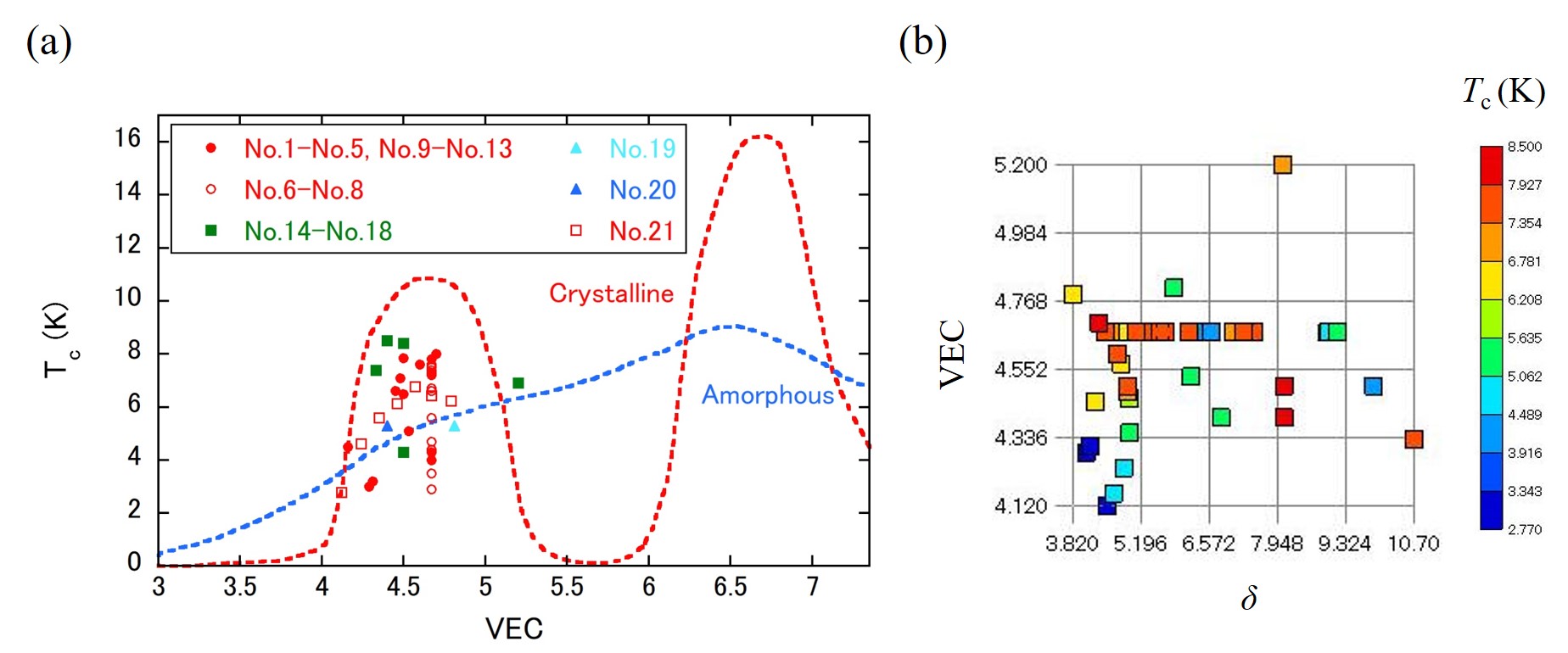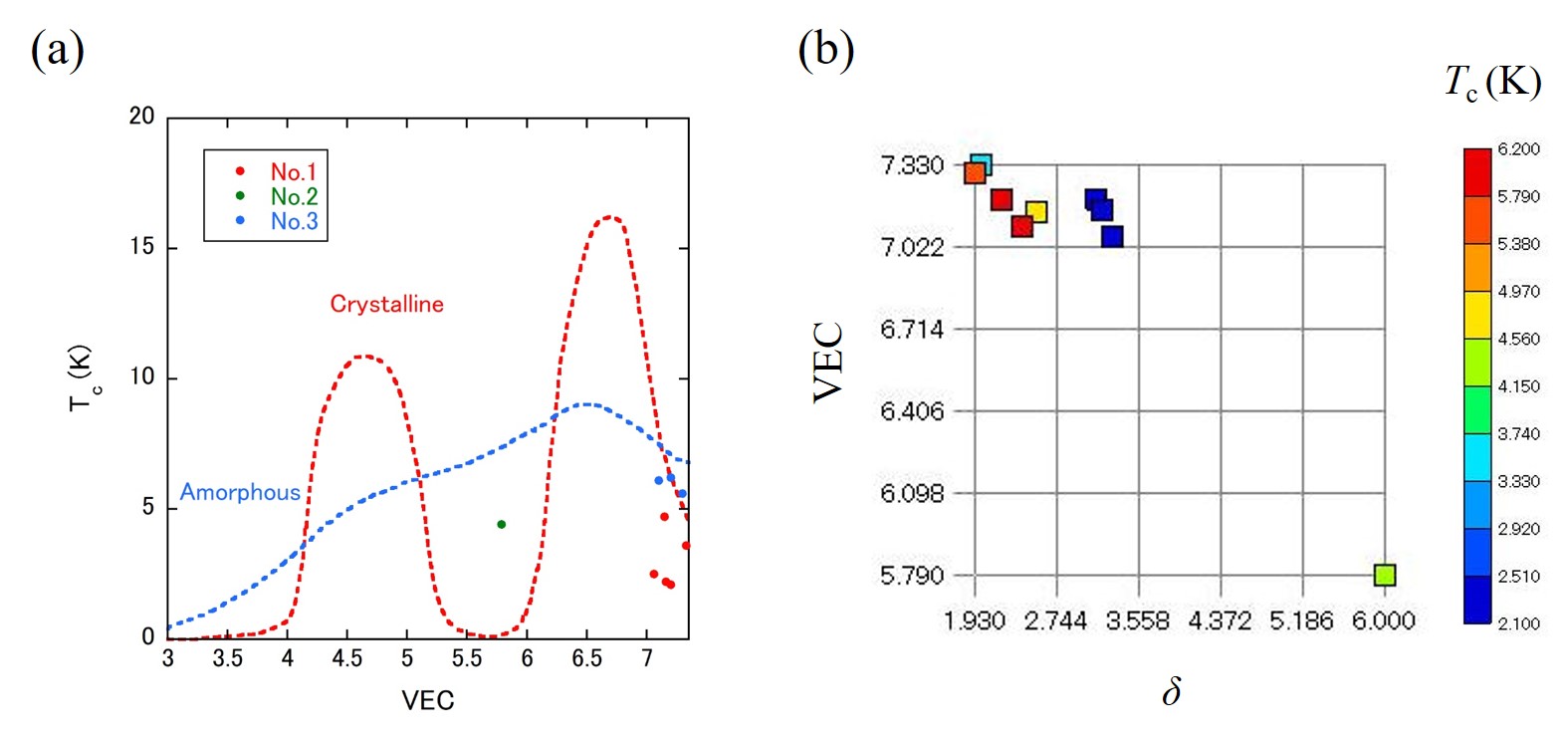Cutting edge of high-entropy alloy superconductors from the perspective of materials research.
- high-entropy alloy
- superconductivity
- body-centered-cubic
- hexagonal-closed packing
- multi-site high-entropy alloy
1. Introduction
High-entropy alloys (HEAs) are a new class of materials which are being energetically studied around the world. HEAs are characterized by a multi-component alloy in which five or more elements randomly occupy a crystallographic site. The conventional HEA concept has developed into simple crystal structures such as face-centered-cubic (fcc), body-centered-cubic (bcc) and hexagonal-closed packing (hcp) structures. HEAs show many superior properties such as a combination of high yield strength and ductility [1], high strength at high temperatures [2], strong resistance to corrosion and oxidation [3], outstanding thermal stability [4] and so on, which are primarily derived from the high atomic disorder. Superconductivity has been one of the topics of focus in the field of HEAs since the discovery of the bcc HEA superconductor in 2014 [5]. A characteristic of superconductivity is robustness against atomic disorder or extremely high pressure. The materials research on HEA superconductors has just begun, and there are open possibilities for unexpectedly finding new phenomena.
2. Influence
The most investigated crystal structure is bcc, in which Hf, Zr, Ti, Ta, Nb, and V with a valence electron count per atom (VEC) value of 4 or 5 represent the dominant chemical components. Almost all bcc HEAs are conventional s-wave phonon-mediated Type II superconductors. In hcp and hcp-related HEA superconductors, contrary to the bcc HEA superconductors, the constituent elements are rather equally distributed on Ti, Nb, Mo, Re, Ru and Rh with different VECs. The hcp Re and Ru elements might play an important role in the stabilization of the hexagonal structure. The VEC dependence of the superconducting critical temperature Tc for the bcc (hcp + hcp-related) HEAs is compared with those for crystalline 4d metal solid solutions and amorphous 4d metals (see Figs.1a and 2a). The results suggest that, in particular, bcc HEA superconductors can be regarded as an intermediate system between crystalline and amorphous superconductors. The stability of the bcc structure is tolerable for δ up to approximately 10; on the other hand, there seems to be little tolerance of δ for hcp phase stability (see Figs.1b and 2b). In the HEA superconductors of both structures, the superconducting state is robust against δ. We also discussed the phase selection of bcc and hcp HEA superconductors based on the average number of itinerant electrons per atom (e/a) and VEC. The simultaneous consideration of e/a and VEC assists in reliable material design (see Fig.3). At the present stage, the formation conditions of bcc and hcp HEA superconductors largely depend on two factors: one is the elemental makeup taking into account the VEC, and the other is the δ-value, representing the atomic size mismatch between the constituents.


Tc
for bcc HEA superconductors. (b)
δ
and VEC dependence of
Tc for bcc HEA superconductors.
for bcc HEA superconductors.




Recently, the concept of HEA has been extended to multi-site crystal structures, and several multi-site HEA superconductors have been reported to be CsCl-type, α-Mn, A15, NaCl-type, σ-phase and layered structures. Some HEAs show a deviation from the Matthias rule of crystalline 4d metal solid solutions; however, a correlation between Tc and VEC is still observed for each crystal structure type. The existence of this correlation suggests the important role of the density of states at the Fermi level determined by the crystal structure. The unexpectedly smaller δ values observed for almost all multi-site HEAs would mean that all sites contribute to the appearance of superconductivity.
[1] Zhou, Y. J.; Zhang, Y.; Wang, Y. L.; Chen, G. L. Microstructure and compressive properties of multicomponent Alx(TiVCrMnFeCoNiCu)100-x high-entropy alloys. Sci. Eng. A 2007, 454–455, 260–265.
[2] Zou, Y; Ma, H; Spolenak, R. Ultrastrong ductile and stable high-entropy alloys at small scales. Commun. 2015, 6, 7748.
[3] Shi, Y.; Yang, B.; Liaw, P. K. Corrosion-resistant high-entropy alloys: A review. Metals 2017, 7, 43.
[4] Sun, L.; Luo, Y.; Ren, X.; Gao, Z.; Du, T.; Wu, Z.; Wang, J. A multicomponent γ-type (Gd1/6Tb1/6Dy1/6Tm1/6Yb1/6Lu1/6)2Si2O7 disilicate with outstanding thermal stability. Res. Lett. 2020, 8, 424-430.
[5] Koželj, P.; Vrtnik, S.; Jelen, A.; Jazbec, S.; Jagličić, Z.; Maiti, S.; Feuerbacher, M.; Steurer, W.; Dolinšek, J. Discovery of a superconducting high-entropy alloy. Rev. Lett. 2014, 113, 107001.
